To celebrate the many cultures in our Limerick community UL Global, TUS & MIC are hosting a photography exhibition, which will capture the diversity present in our universities set in some of the incredible places and scenes of Limerick.
‘Muintir’, has a wide range of meanings, including family, household, community, kin. It speaks not only of your immediate relatives, but the wider groups of people from whom you descend by virtue of ancestry, or to whom you belong by choice. Our history, our lineage and who came before us. No matter where we come from and who we are, we are all linked through our common story.
We are connected.
Artist: Shane Serrano
Curated by Alli McNamara, University of Limerick
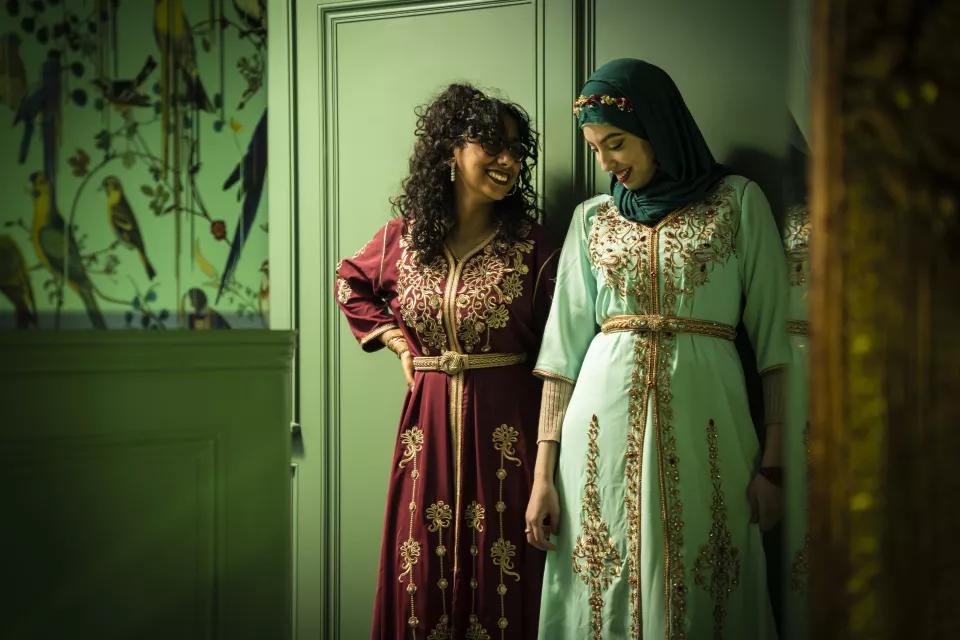
Ghalia Arid and Douaa Soumeur, Algeria
University of Limerick
Ghalia Arid an Algerian 3rd year PhD student at the University of Limerick. Douaa Soumeur, is also from Algeria and is a PhD student in Arts, Humanities, and Social Sciences at the University of Limerick.
The dresses worn by Douaa and Ghalia are well known in the north western countries in Africa, namely Algeria and Morocco and is called a Caftan. The design differs in terms of colour, fabric and the way it is sewn using one or two pieces. It is mostly worn during weddings or any special occasions.
Ghalia and Douaa are pictured at No.1 Pery Square, a luxurious and intimate boutique townhouse and one of the country’s prettiest and most characterful hotels. No. 1, is one of a terrace of six Georgian houses built around 1830 by the Pery Square Tontine Company, Widely regarded as being the best example of late Georgian architecture in Limerick and probably in Ireland, No.1 is the wonderful building that wraps around the corner of this impressive terrace.
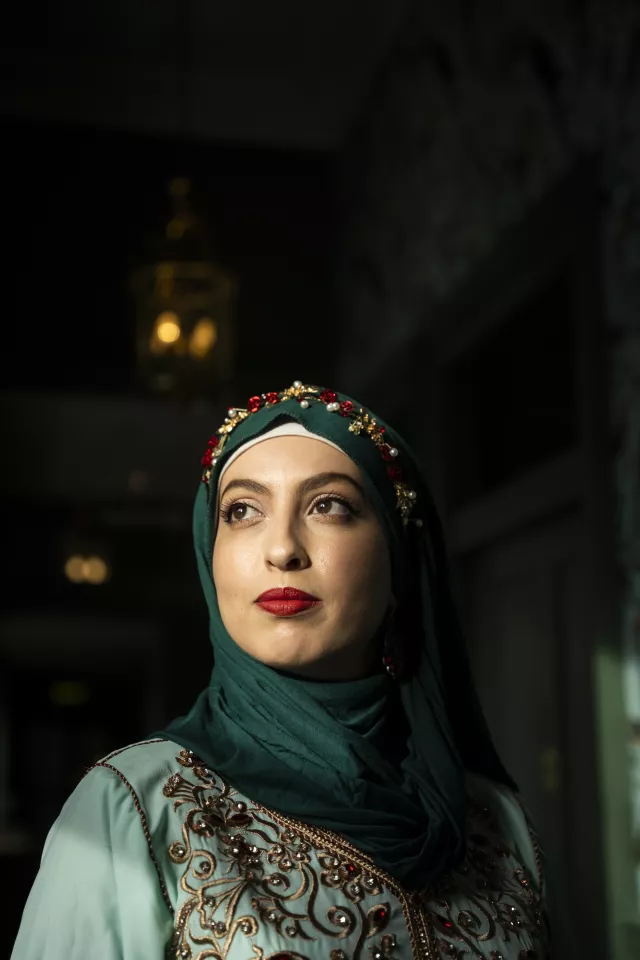
Douaa Soumeur, Algeria
University of Limerick
Douaa Soumeur, is from Algeria and is a PhD student in Arts, Humanities, and Social Sciences at the University of Limerick. Douaa is wearing a traditional dress called a Caftan, the design differs in terms of colour, fabric and the way it is sewn using one or two pieces. It is mostly worn during weddings or any special occasions.
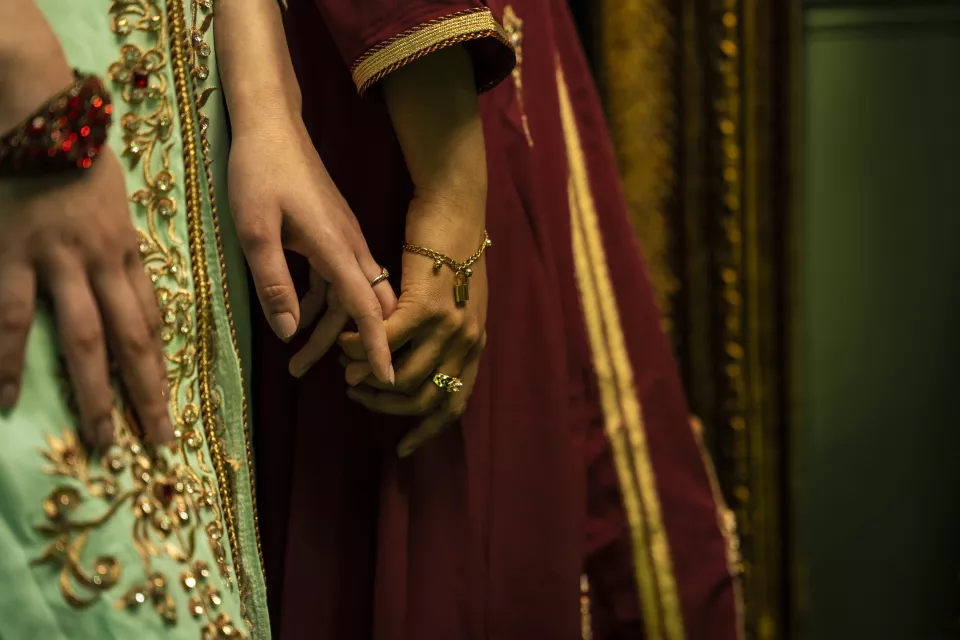
Ghalia Arid and Douaa Soumeur, Algeria
University of Limerick
Ghalia Arid an Algerian 3rd year PhD student at the University of Limerick. Douaa Soumeur, is also from Algeria and is a PhD student in Arts, Humanities, and Social Sciences at the University of Limerick.

Faith Freake, Canada
University of Limerick
Faith, a proud Newfoundlander is pursuing a Bachelor of Science (honours), Joint in Chemistry and Biochemistry alongside a Criminology Certificate. Faith is wearing an eternity scarf of the Newfoundland and Labrador Tartan. Tartans were first brought to Canada by Scottish settlers, and represent each Canadian province. A St. John’s local designed the pattern in the early 1960s with colours representative of the province’s official anthem, “Ode to Newfoundland”.
The tartan includes a green background with colours of gold, white, brown and red. The green is representative of the ‘pine-clad hills’ or forests; the gold of the ‘sun’s rays’; the white of the ‘cloak of snow’; the brown of the ‘Iron Isle’ known as Bell Island; and the red of the ‘Royal Standard of which our fathers stood’.
Faith is pictured outside the Medical School colonnade on the University of Limerick campus, with the limestone clad façade from locally sourced materials is lit up pink to reflect the ink colour of the Newfoundland Tricolour.
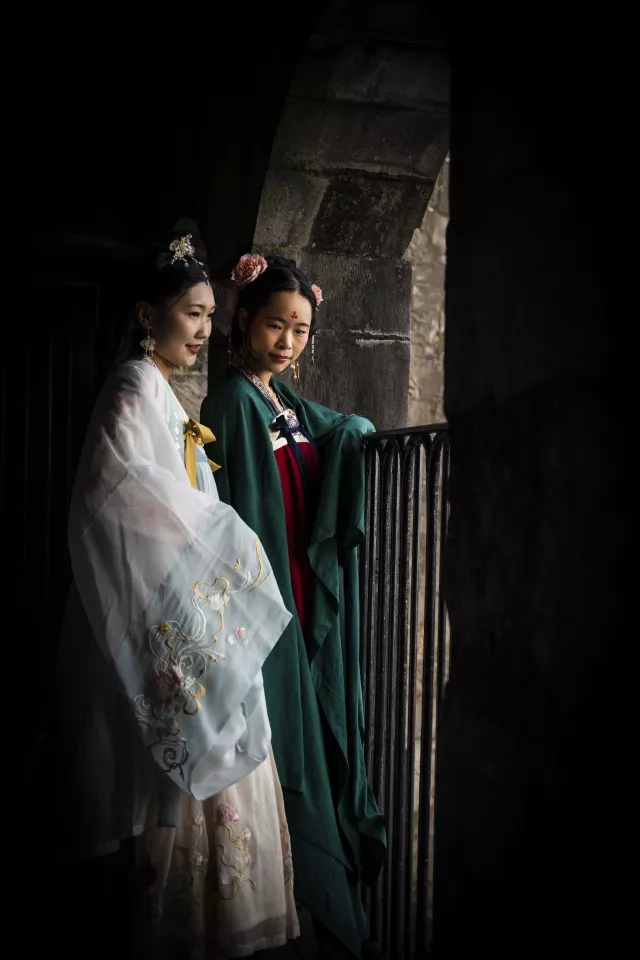
Jun Zheng and Liang Huan, China
University of Limerick & Technological University of the Shannon
Studying a Masters in Ethnomusicology, Jun Zheng from China is dressed in a traditional Chinese dress, the Ruqun, which is approximately 1500 years old. It has a loose hemline to allow women to walk and dance with ease. The Ruqun comes in a variety of bright and vibrant colours and patterns such as red, green and blue, which are symbolic of enthusiasm, celebration and blessing.
Liang, also from China is enrolled in Digital Marketing at the Technological University of the Shannon, she is wearing the Hanfu, a traditional dress of the Han Chinese people. The one displayed here is worn by women in the Tang Dynasty, which is approximately 1200 years old. The Tang dynasty was one of the most prosperous periods in Chinese history, so the Chinese dress is very elegant and luxurious. At the same time, the first female emperor of China appeared in 690 AD and the status of women increased significantly, so the style of women's dress would have been more open than in other dynasties. This Hanfu is a modified version of an ancient Dunhuang painting and takes on the classic red and green colour scheme, perfectly demonstrating the traditional Chinese style.
Jun and Huan are pictured on the Balcony of King Johns Castle overlooking the 13th-century castle courtyard and Limerick city. Built in the 13th century by King Johns Castle has had a very long and turbulent history dating back to Viking times and has undergone several sieges, battles and triumphs over its long history.
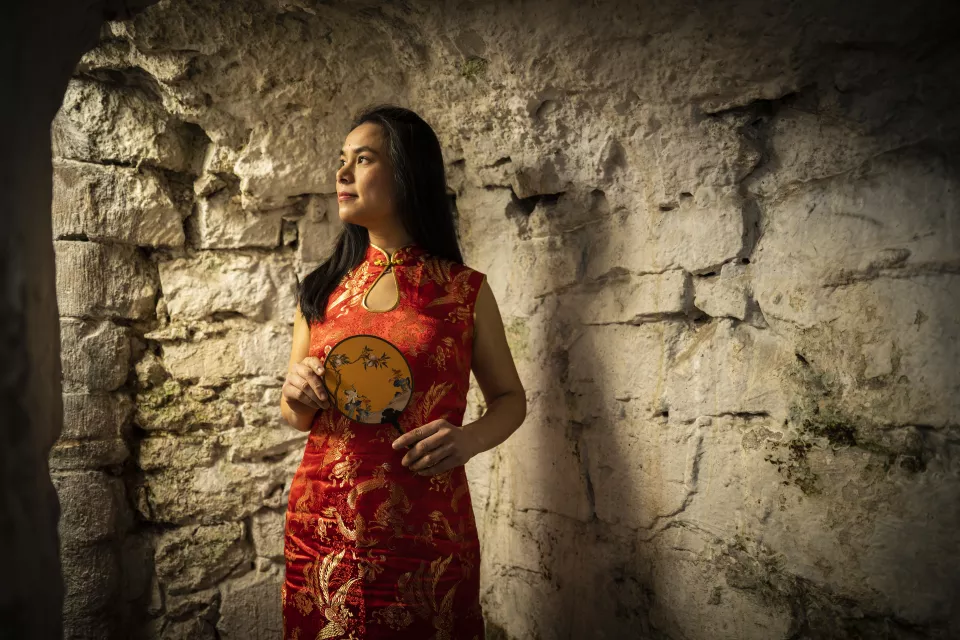
Lili Wang, China
Mary Immaculate College
Lili Wang, currently enrolled in a Master of Applied Linguistics at Mary Immaculate College, Lili is dressed in red, which represents happiness and good fortune in China.
The Phoenix seen on the dress is believed to be an immortal bird, rebirthed from Nirvana and acts as a symbol of fire.
Lili is pictured within the passageways and staircases of the 13th century King John’s Castle, the passageways are perfectly persevered with over 800 years of character.
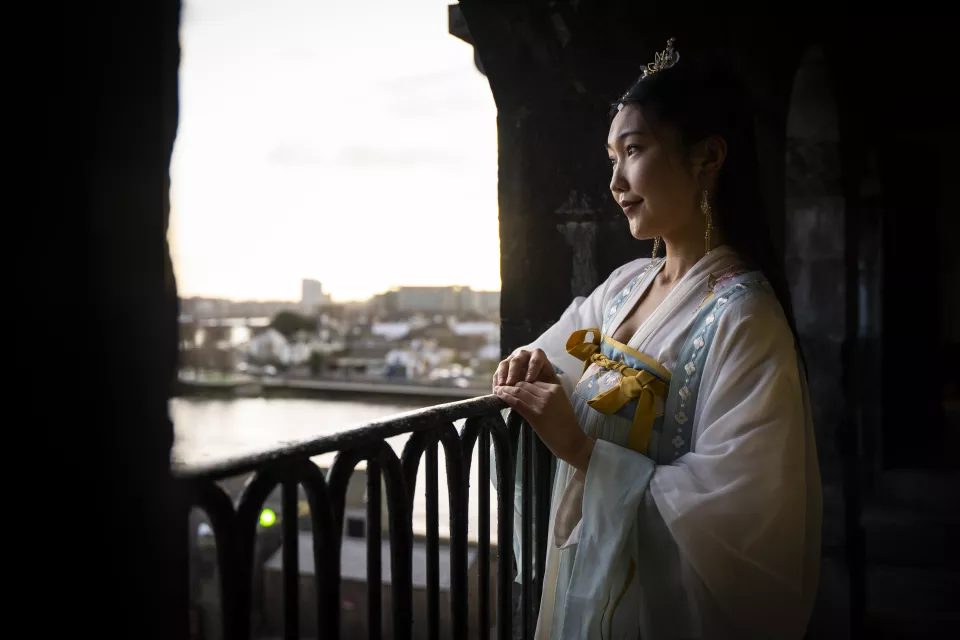
Jun Zheng, China
University of Limerick
Studying a Masters in Ethnomusicology, Jun Zheng from China is dressed in a traditional Chinese dress, the Ruqun, which is approximately 1500 years old. It has a loose hemline to allow women to walk and dance with ease. The Ruqun comes in a variety of bright and vibrant colours and patterns such as red, green and blue, which are symbolic of enthusiasm, celebration and blessing.
Jun is pictured on the Balcony of King Johns Castle overlooking the 13th-century castle courtyard and Limerick city. Built in the 13th century by King Johns Castle has had a very long and turbulent history dating back to Viking times and has undergone several sieges, battles and triumphs over its long history.
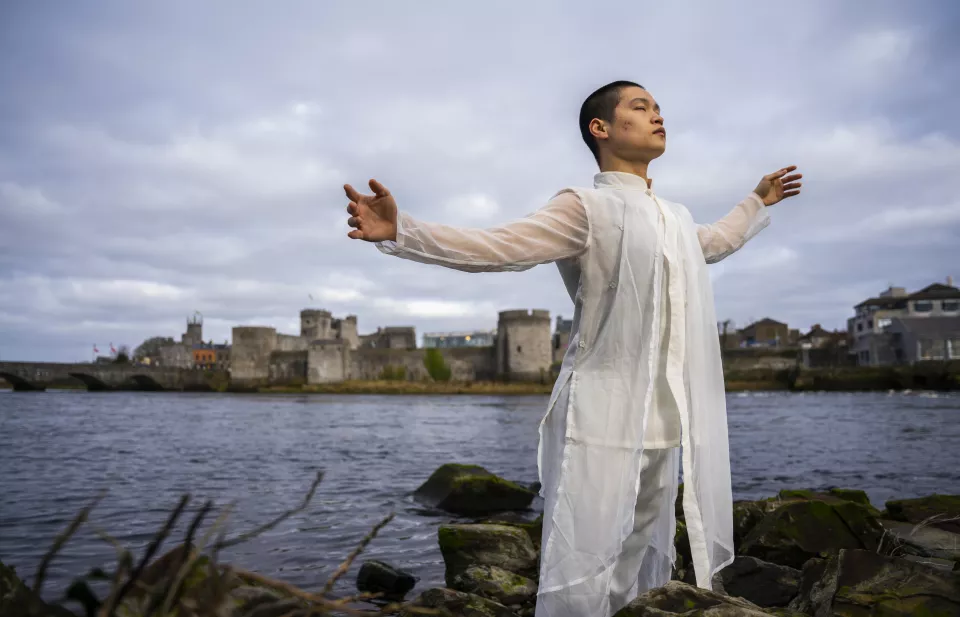
Wuxun Du, China
University of Limerick
Wuxun Du, from China, a graduate of Contemporary Dance at the University of Limerick, is pictured here in traditional Chinese clothes, denoted by the stand-up collar and buttons.
Wuxun chose the colour white as it signifies purity, tranquillity and holiness and is inspired by the surroundings. He immerses himself in the natural environment allowing for limitless self-expression and a feeling of being at one with nature.
Wuxun is pictured at the Curragower Falls on Clancy Strand in the heart of Limerick city under the shadow of King John's castle. The falls are formed when the river Shannon drops over a rock ledge at the right tide.
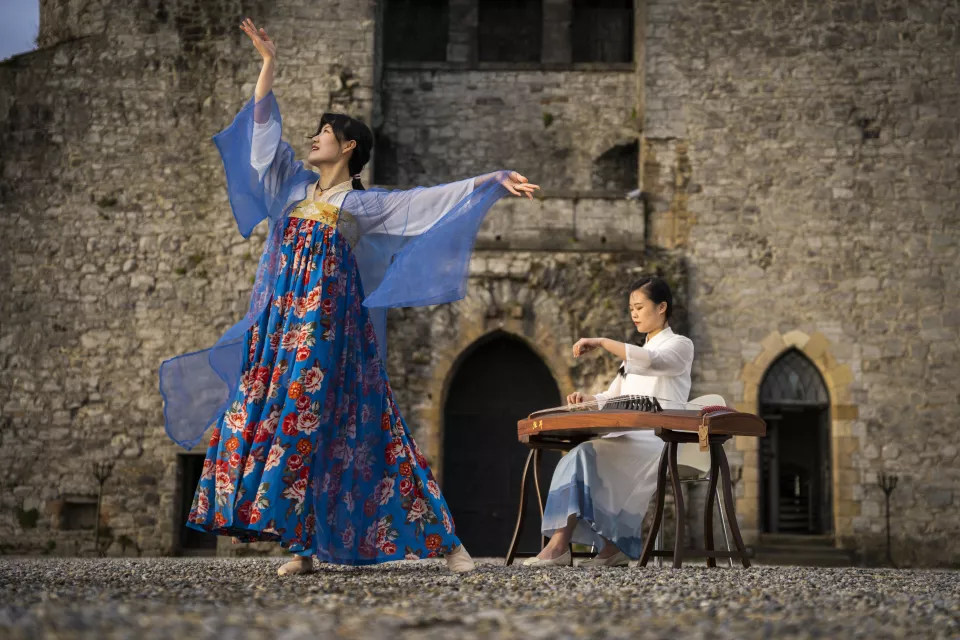
Jiating Li and Xiaoyu Fu, China
University of Limerick
Jiating Li who is completing a Master of Arts and Dance Performance & Xiaoyu Fu majoring in Ethnomusicology are both from China.
Here Xiaoyu is dressed in a modified version of the Chinese Cheongsam coupled with the traditional stand-up collar. The bottom half of the dress is a combination of blue and white, representing the beauty and showing the mood of an ancient Chinese landscape painting. Jiating is dressed in the traditional ‘Hanbok’ while demonstrating Chinese dance movements
Jiating and Xiaoyu are pictures in the interactive courtyard of King John’s castle, pictured by the impressive original entrance, stone curtain walls and balconies.
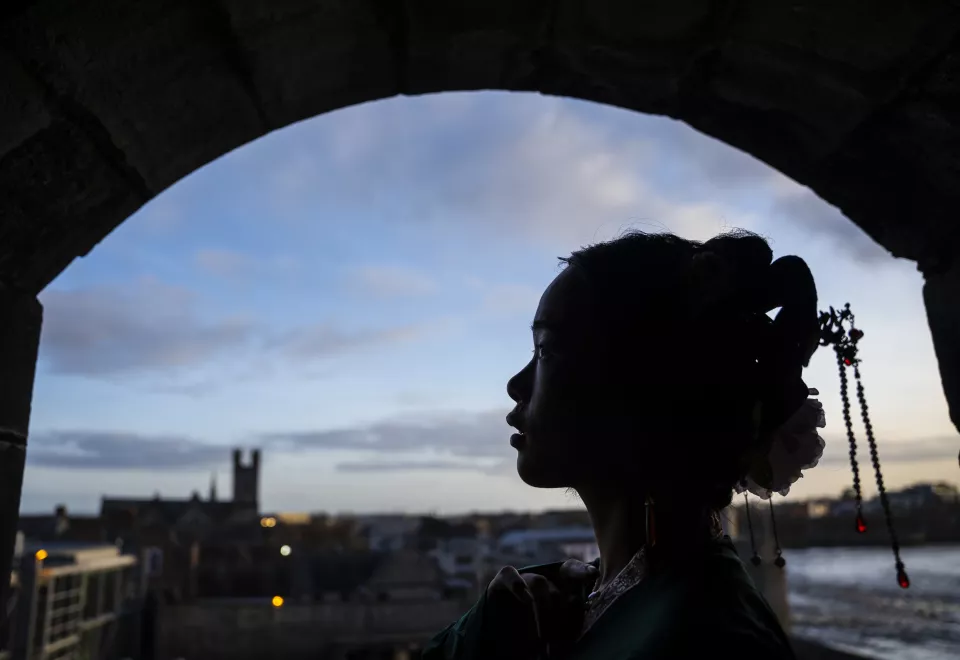
Liang Huan, China
Technological University of the Shannon
Liang, from China is enrolled in Digital Marketing at Technological University of the Shannon. She is wearing the Hanfu, a traditional dress of the Han Chinese people paired with hair ornament, Bu Yao. Bu Yao became popular in the Han Dynasty, It looks like a hairpin Zan, but with pendants or fringes, which would swing when someone is wearing it and walking.
Liang is framed by the arched balcony at the top of King Johns Castles battlements with views of Limerick city and the majestic river Shannon.

Lili Wang, China
Mary Immaculate College
Lili Wang, currently enrolled in a Master of Applied Linguistics at Mary Immaculate College, Lili is dressed in red, which represents happiness and good fortune in China.
The Phoenix seen on the dress is believed to be an immortal bird, rebirthed from Nirvana and acts as a symbol of fire.
Lili is pictured within the passageways and staircases of the 13th century King John’s Castle. The passageways are perfectly preserved with over 800 years of character.

Jiating Li and Xiaoyu Fu, China
University of Limerick
Jiating Li who is completing a Master of Arts and Dance Performance & Xiaoyu Fu majoring in Ethnomusicology are both from China.
Here Xiaoyu is dressed in a modified version of the Chinese Cheongsam coupled with the traditional stand-up collar. The bottom half of the dress is a combination of blue and white, representing the beauty and showing the mood of an ancient Chinese landscape painting. Jiating is dressed in the traditional ‘Hanbok’ while demonstrating Chinese dance movements
Jiating and Xiaoyu are pictures in the interactive courtyard of King John’s castle, pictured by the impressive original entrance, stone curtain walls and balconies.
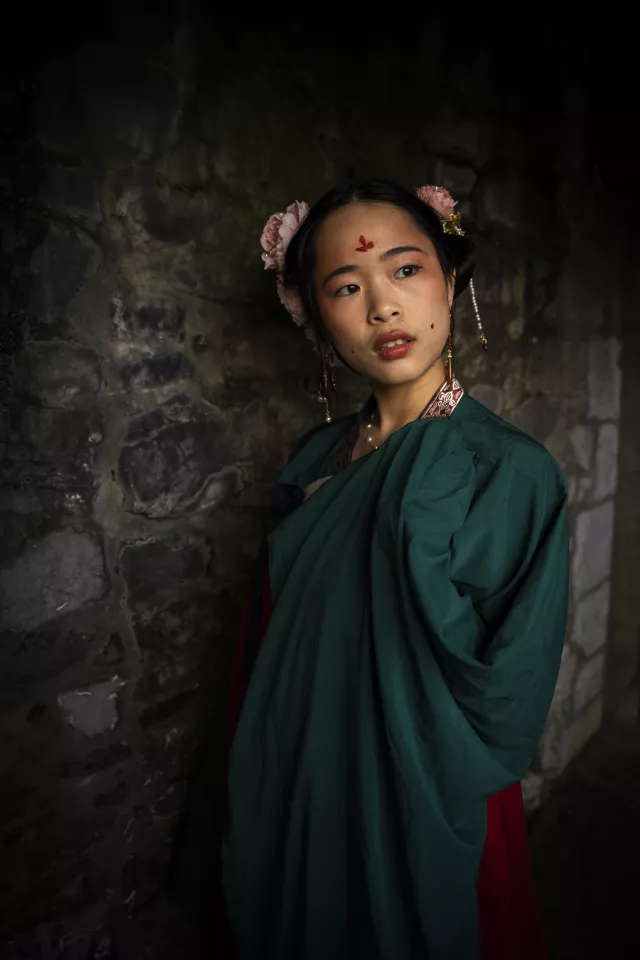
Liang Huan, China
Technological University of the Shannon
Liang, from China is enrolled in Digital Marketing at Technological University of the Shannon. She is wearing the Hanfu, a traditional dress of the Han Chinese people paired with hair ornament, Bu Yao. Bu Yao became popular in the Han Dynasty, It looks like a hairpin Zan, but with pendants or fringes, which would swing when someone is wearing it and walking.
Liang is framed by the arched balcony at the top of King Johns Castles battlements with views of Limerick city and the majestic river Shannon.
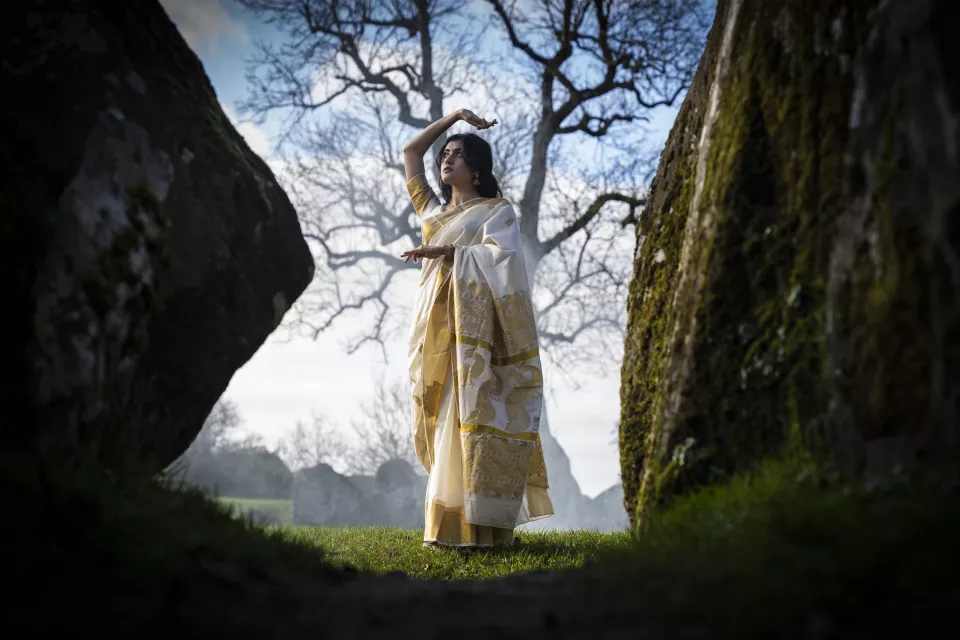
Nandini Mohan, India
University of Limerick
Nandini from New Delhi in India is pursuing a Master of Psychological Science, with a passion for all things mental health. Pictured here wearing Kerala’s traditional kasavu saree, which stands out for its elegance and visual restraint.
Beneath its simple appearance lies a cultural legacy and unique aesthetic. Worn by the Malayali community to temples and weddings. The White and gold saree stands out for its elegance and auspiciousness on Onam. This saree is associated with a very old cultural heritage and unique art.
Nandini is pictured at Grange stone circle, the largest in Ireland. 150 feet in diameter and enclosed by 113 standing stones. The largest stone is Rannach Chruim Duibh (Crom Dubh’s Division) and is over 13 feet high and weighs 40 tons. The entrance stones are matched by a pair of equally impressive slabs on the southwest side, whose tops slope down towards each other to form a V-shape.
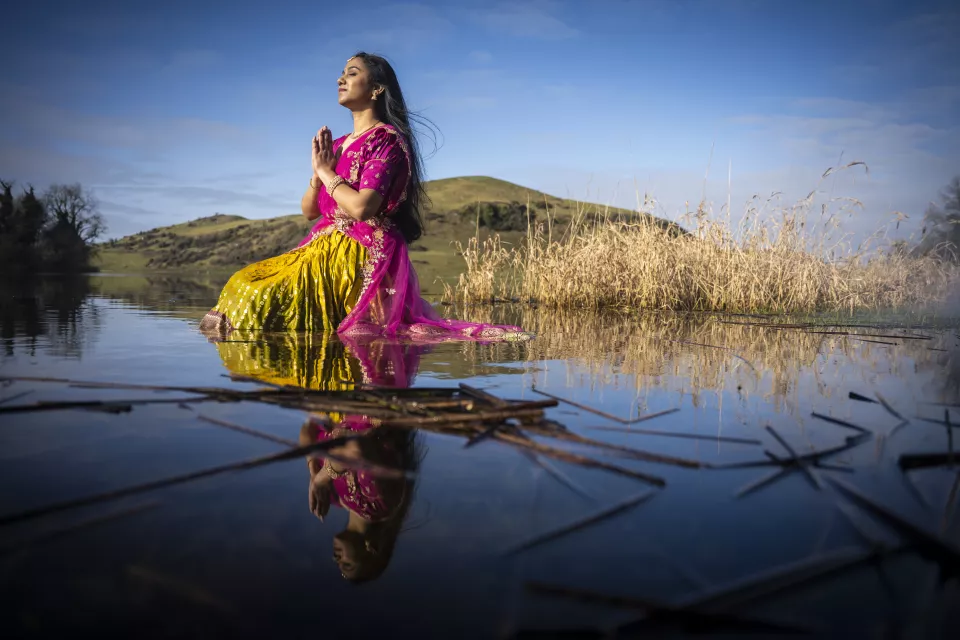
NIKHITHA MADINENI, India
University of Limerick
Nikhitha, a designer from Hyderabad, India is currently pursuing an MSc in UI/UX Design.
She is captured here wearing a traditional Telugu outfit consisting of a pink voni and yellow lehenga, symbolising happiness and prosperity. This style of dress is typically worn for special occasions and celebrations.
In this image, Nikhitha is performing a ‘namaskaram’ gesture as a sign of respect and devotion. This pose has deep roots in Indian culture and is often used in religious and spiritual contexts. By combining this traditional gesture with the natural beauty of the sun and water, It conveys a sense of reverence for the natural world and the divine forces that underlie it.
Nikhitha is pictured in Lough Gur. The lake is fed from underground springs and is not free flowing. The lake and the surrounding area is known to be one of Ireland’s most important archaeological sites. Humans have lived in Lough Gur since Neolithic times. The site of Lough Gur is the only area in all of Ireland where you will see visible remains of every age of mankind throughout the centuries.
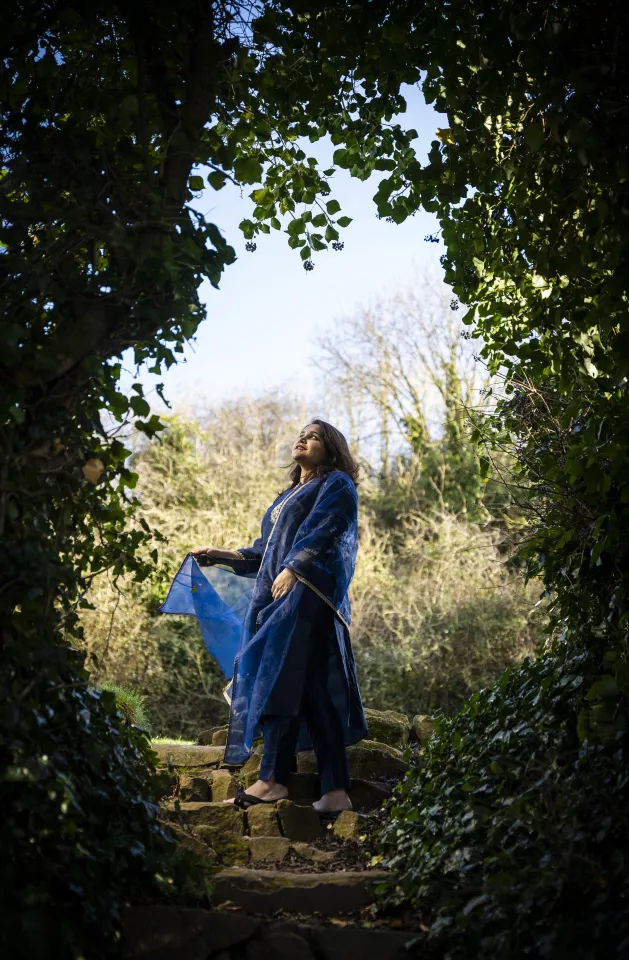
Swapna Sudha Sabut, India
University of Limerick
Swapna Sudha, from Odisha, India, pursuing MSc. Business Analytics at the University of Limerick. Swapna is proudly wearing the ‘salwar kameez’, a traditional outfit worn by Indian women. It comprises a pair of trousers known as the salwar and a tunic called the kameez. The salwar kameez is usually paired with a long, sheer fabric scarf or shawl known as a dupatta, which is either draped across the neck or over the head. Decorative patterns may also be embroidered around the neckline, sleeves, hems, and side slits of the outfit. The touch of colour, and the intricate designs exhibit the culture of every state of India.
Swapna is pictured at Lough Gur at the heart of a remarkable archaeological landscape featuring sites that represent every major period of human history in Ireland. Legend states that Lough Gur is home to Gearóid Iarla who was banished to the bottom of the lake by the Goddess Áine. He will return to the surface every 7 years in an effort to break the curse that was placed upon him. Once the silver of his shoes wears thin Gearóid will walk among us again…
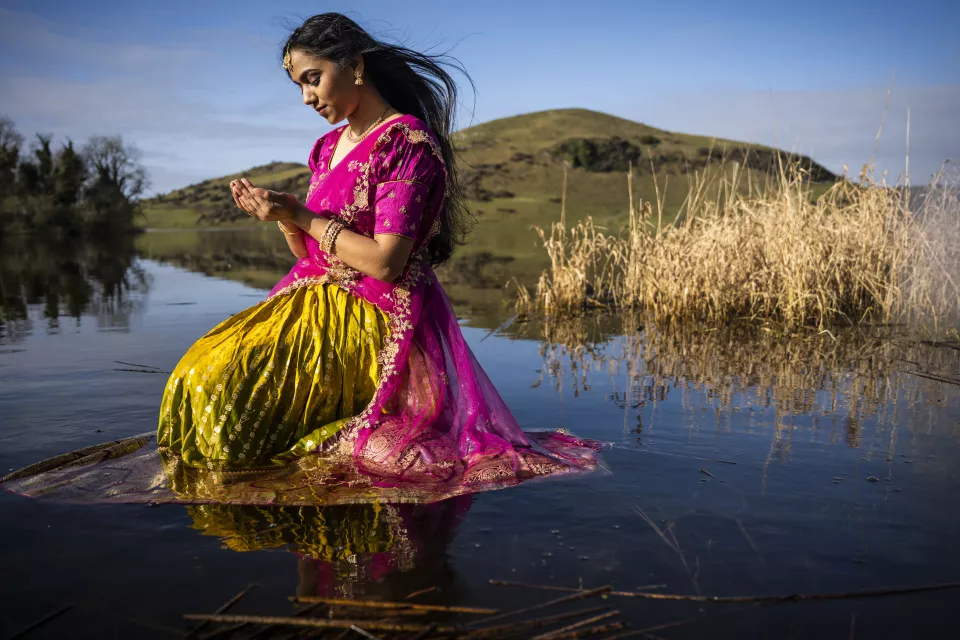
NIKHITHA MADINENI, India
University of Limerick
Nikhitha, a designer from Hyderabad, India is currently pursuing an MSc in UI/UX Design.
She is captured here wearing a traditional Telugu outfit consisting of a pink voni and yellow lehenga, symbolising happiness and prosperity. This style of dress is typically worn for special occasions and celebrations.
Nikhitha is pictured in Lough Gur. The lake is fed from underground springs and is not free flowing. The lake and the surrounding area is known to be one of Ireland’s most important archaeological sites.
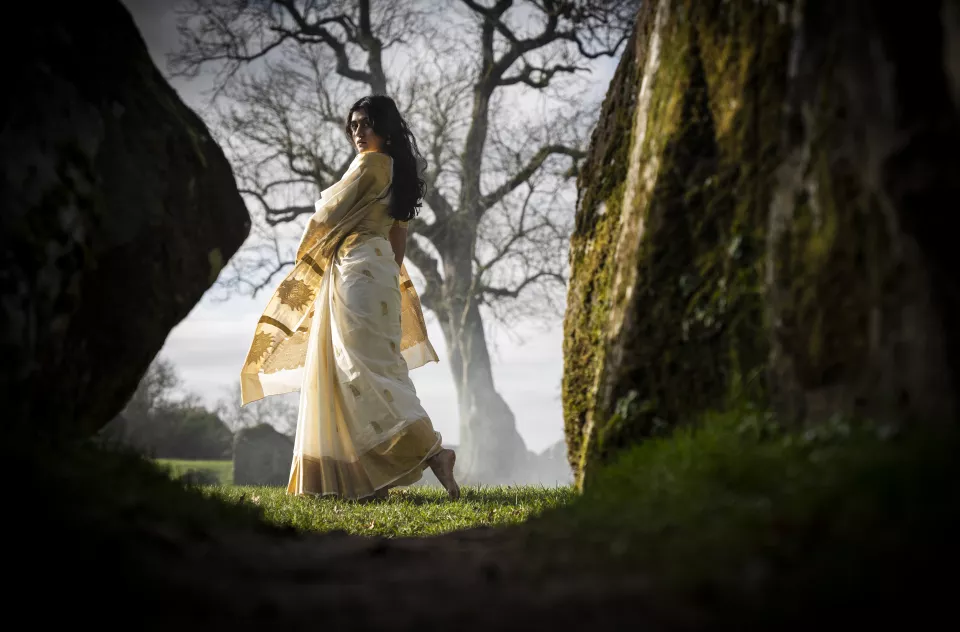
Nandini Mohan, India
University of Limerick
Nandini from New Delhi in India is pursuing a Master of Psychological Science, with a passion for all things mental health. Pictured here wearing Kerala’s traditional kasavu saree, which stands out for its elegance and visual restraint.
Beneath its simple appearance lies a cultural legacy and unique aesthetic. Worn by the Malayali community to temples and weddings. The White and gold saree stands out for its elegance and auspiciousness on Onam. This saree is associated with a very old cultural heritage and unique art.
Nandini is pictured at Grange stone circle, the largest in Ireland. 150 feet in diameter and enclosed by 113 standing stones. The largest stone is Rannach Chruim Duibh (Crom Dubh’s Division) and is over 13 feet high and weighs 40 tons. The entrance stones are matched by a pair of equally impressive slabs on the southwest side, whose tops slope down towards each other to form a V-shape.
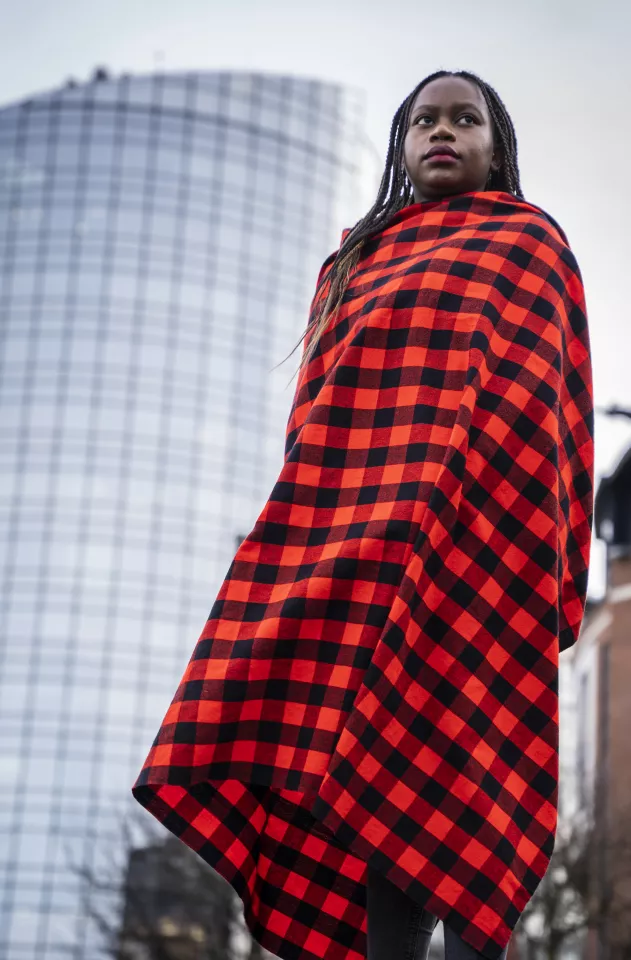
Sarah Lavender Achieng, Kenya
University of Limerick
Sarah, from Kenya, is in the midst of an MSc in Aeronautical Engineering. She is wrapped in a 'Maasai shuka' popularised by the Maasai people of East Africa as their traditional clothing. The 'shuka' comes in different arrays of patterns and colours and is a common household item as a throw or personal blanket, providing just the perfect feeling of home away from home.
Sarah is pictured at Mount Kenneth Skate Park Limerick city centre’s only dedicated skatepark, which has been situated at Mount Kennett Place for almost thirteen years. In the background you can see Riverpoint, a two tower mixed-use building complex located on Bishops Quay.
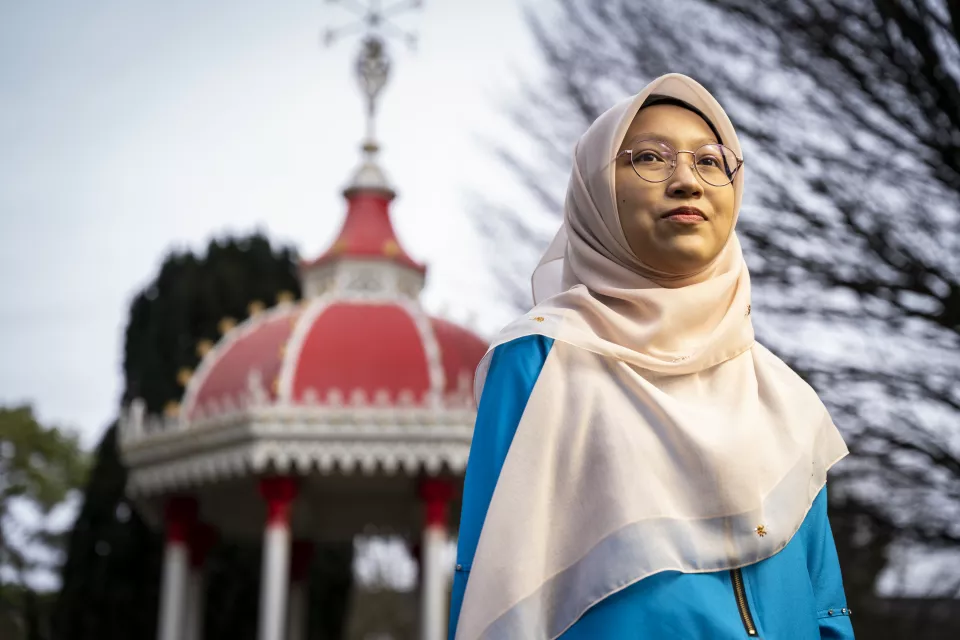
ATHIRAH BINTI MOHD RAFI, Malaysia
University of Limerick
Athirah from Malaysia is studying Linguistics with TESOL and Digital Culture and Communication.
Athirah is wearing a Malay traditional costume called Baju Kurung. It comprises of two pieces of clothing; a blouse and a skirt. It is the national dress of Malaysia. Generally, all Malay women wear Baju Kurung as the formal attire at work and this includes primary and secondary school students. It is considered as the school uniform for girls. Apart from that, it is also worn to attend official functions, weddings and religious ceremonies. But there are many versions of Baju Kurung with different styles and patterns. It changes according to time but still retains the original features.
Athirah is pictures in front of the Richard Russell Fountain the People’s Park, Officially opened in 1877 the People’s Park was given to the people of Limerick in honour of Richard Russell, a prominent local businessman and highly regarded employer. A drinking fountain provided by employees of Russell Flour Mills and the former Carnegie Library was also unveiled at the same time.
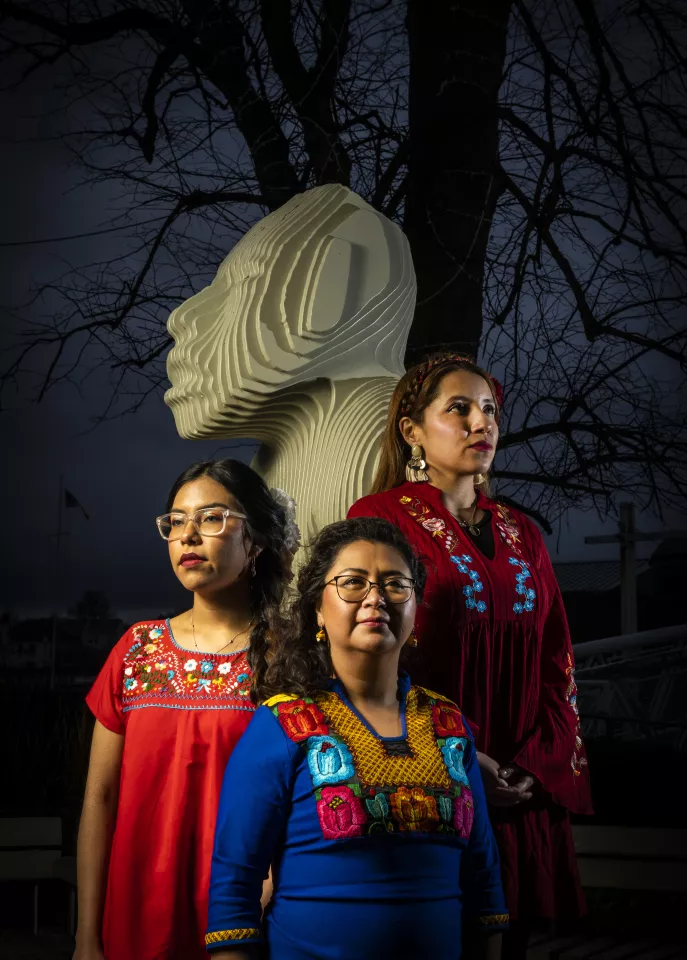
Brenda Munoz Gonzalez, Montserrat Ibarra & Priscilla Rivera Contreras, Mexico
University of Limerick
Brenda, Montserrat and Priscila have all come from Mexico and are studying at the University of Limerick. They study Human nutrition and dietetics, International Management & Global Business and European Studies respectively.
Brenda’s red blouse is embroidered with the San Antonino technique. It is done by hand with silk thread on a cotton fabric that captures butterflies, hummingbirds, roses, jasmine, lilies, which can be multi-coloured or in a single tone. This is a casual blouse that can be worn in everyday settings.
Montserrat, aiming to show how colourful and diverse Mexico is and is reflected in her colourful outfit. The hair braids are also symbolic for Mexican women representing resistance, culture embracement and honour.
The dress worn by Priscila has an embroidery representative of Oaxaca, specifically, from the Isthmus of Tehuantepec. Oaxaca is located in the southwestern region of Mexico, recognised as one of the States of the Mexican Republic with the greatest cultural roots and a niche for outstanding artisans.
The technique used for this type of embroidery is traditionally on a pedal loom and shuttles, with cotton thread, natural in colour and dyed with natural and artificial dyes. The main elements in these embroideries are the flowers and the colours that give life to this art.
Brenda, Montserrat and Priscila are pictured in the Hunt Museum garden alongside the Olmec Man, The Olmec were one of the earliest civilisations in Mesoamerica. modern-day Mexico. Pre-dating the Aztecs and the Maya, the Olmec were great craftspeople and artists who appear to have had elaborate burial rites. Olmec Man is like sculptures found in a burial at the Olmec city La Venta, which flourished between c. 900 – 400 BC.
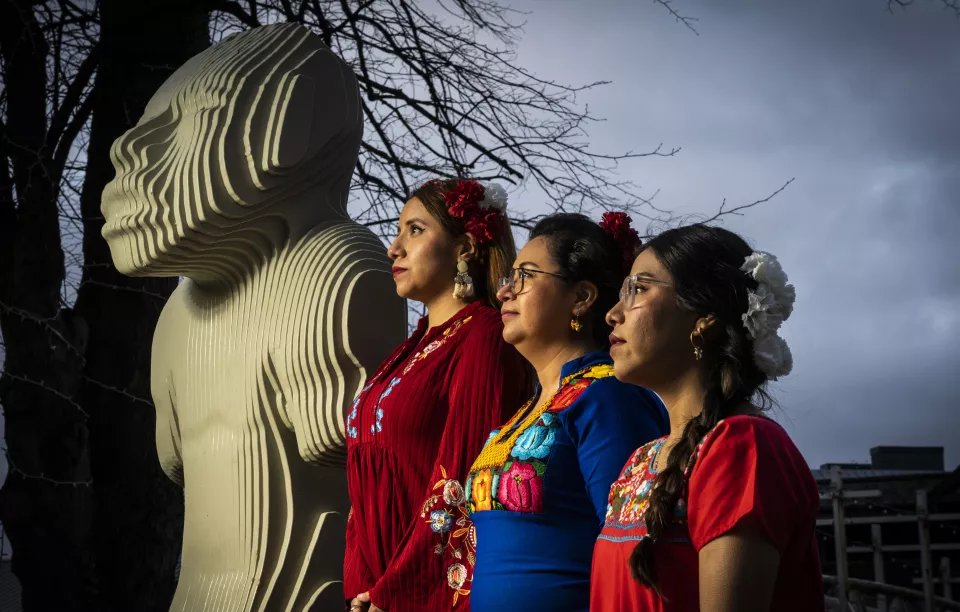
Brenda Munoz Gonzalez, Montserrat Ibarra & Priscilla Rivera Contreras, Mexico
University of Limerick
Brenda, Montserrat and Priscila have all come from Mexico and are studying at the University of Limerick. They study Human nutrition and dietetics, International Management & Global Business and European Studies respectively.
Brenda, Montserrat and Priscila are pictured in the Hunt Museum garden alongside the Olmec Man, The Olmec were one of the earliest civilisations in Mesoamerica. modern-day Mexico. Pre-dating the Aztecs and the Maya, the Olmec were great craftspeople and artists who appear to have had elaborate burial rites. Olmec Man is like sculptures found in a burial at the Olmec city La Venta, which flourished between c. 900 – 400 BC.
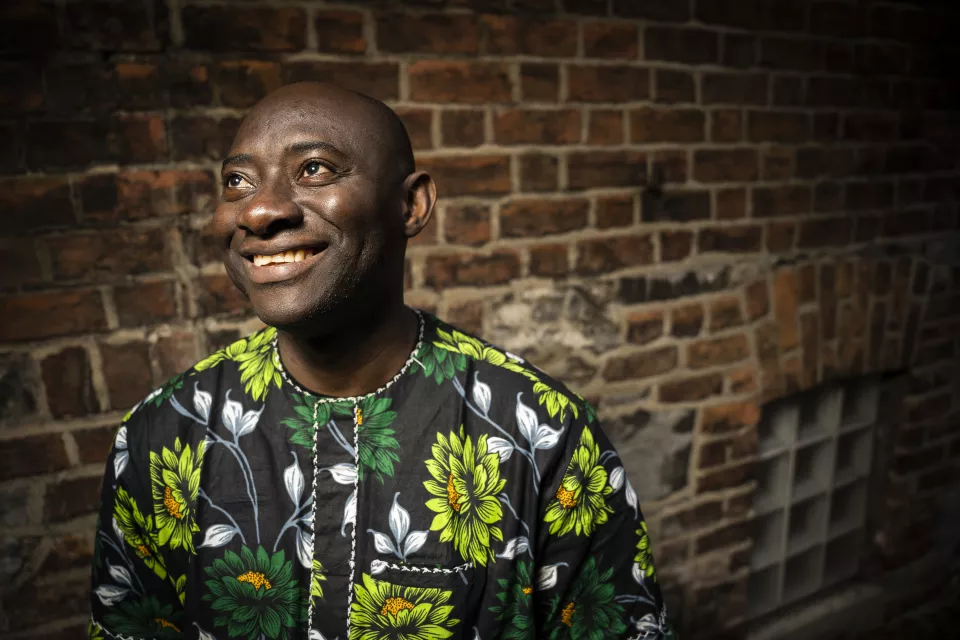
Olufisayo Olujenyo Alo, Nigeria
University of Limerick
Olufisayo from Nigeria is currently studying a Master of Community Research & Development. His dress, traditionally known as ‘buba’ and ‘sokoto’, is an everyday item worn by the Yoruba tribe in Southwest Nigeria. Yorubas are a colourful people demonstrated by their fashion. This dress is embroidered by hand and can be complimented by wearing a cap and agbada.
Olufisayo is pictured in the heart of Georgian Limerick in Perry square framed by the red bricks associated with Georgian architecture from the 18th and early 19th century. Limerick’s Georgian Quarter is one of the most intact historic Georgian city centres and includes some of the finest examples of Georgian architecture in the country.
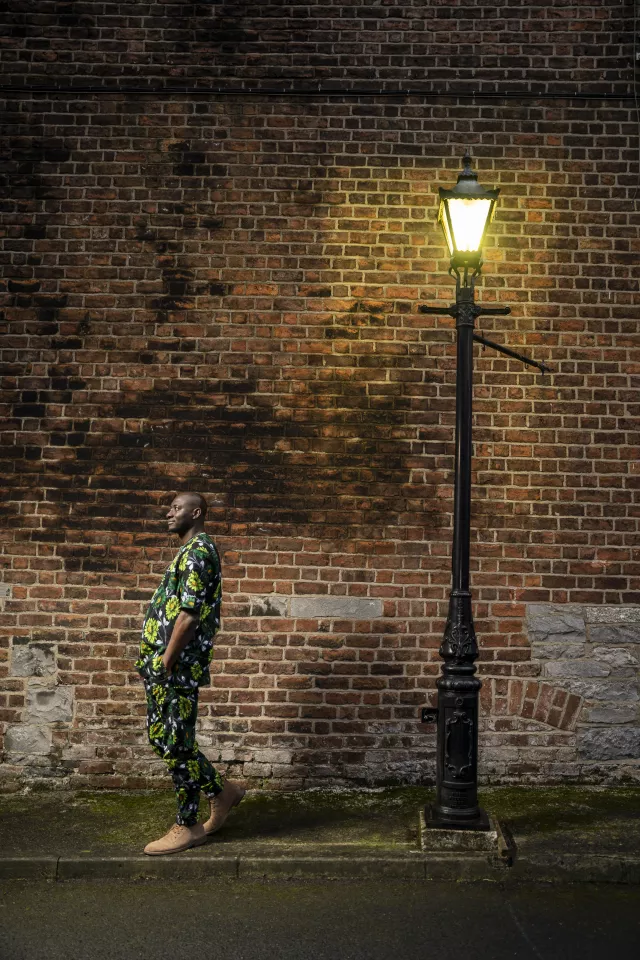
Olufisayo Olujenyo Alo, Nigeria
University of Limerick
Olufisayo from Nigeria is currently studying a Master of Community Research & Development. His dress, traditionally known as ‘buba’ and ‘sokoto’, is an everyday item worn by the Yoruba tribe in Southwest Nigeria. Yorubas are a colourful people demonstrated by their fashion. This dress is embroidered by hand and can be complimented by wearing a cap and agbada.
Olufisayo is pictured in the heart of Georgian Limerick in Perry square framed by the red bricks associated with Georgian architecture from the 18th and early 19th century. Limerick’s Georgian Quarter is one of the most intact historic Georgian city centres and includes some of the finest examples of Georgian architecture in the country.
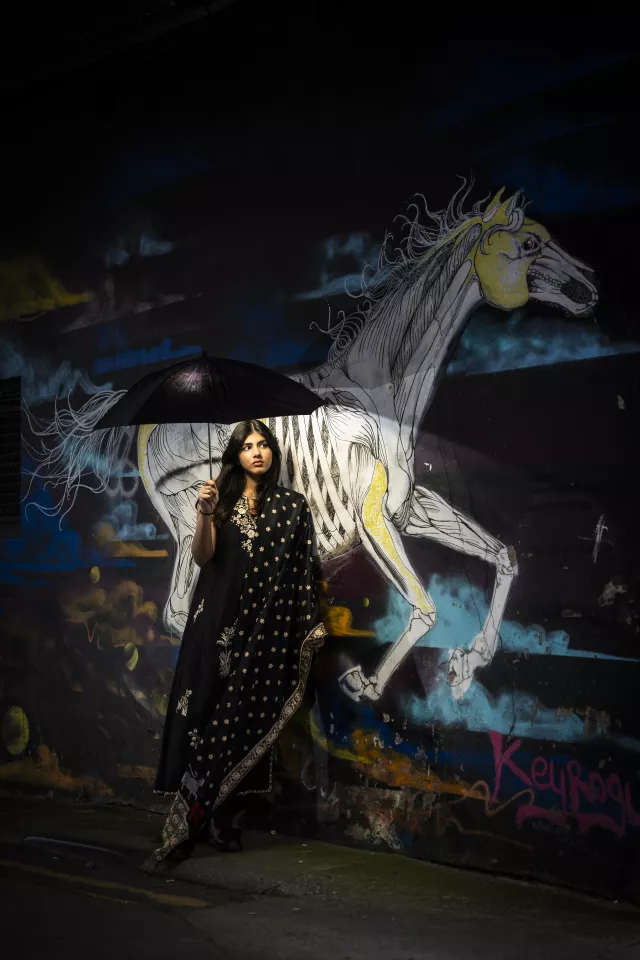
Arisha Atif, Pakistan
University of Limerick
Arisha Atif, studying Social Science, is wearing a traditional Pakistani dress, with her favourite piece being her "dupatta", which translates into shawl.
In Pakistan, dresses are worn daily, although they are not as brightly embroidered as this one. Rather, colourfully designed and shinier dresses are worn on special occasions, such as Eid or weddings. Because of the hot weather in Pakistan, these dresses are often made of light material, such as silk.
Arisha is pictured in Upper William Street in front of one of Limericks many street art installations. Renowned street artists from all over the world come to Limerick to make their mark, and what they leave behind are vibrant, evocative, uniting murals and messages.
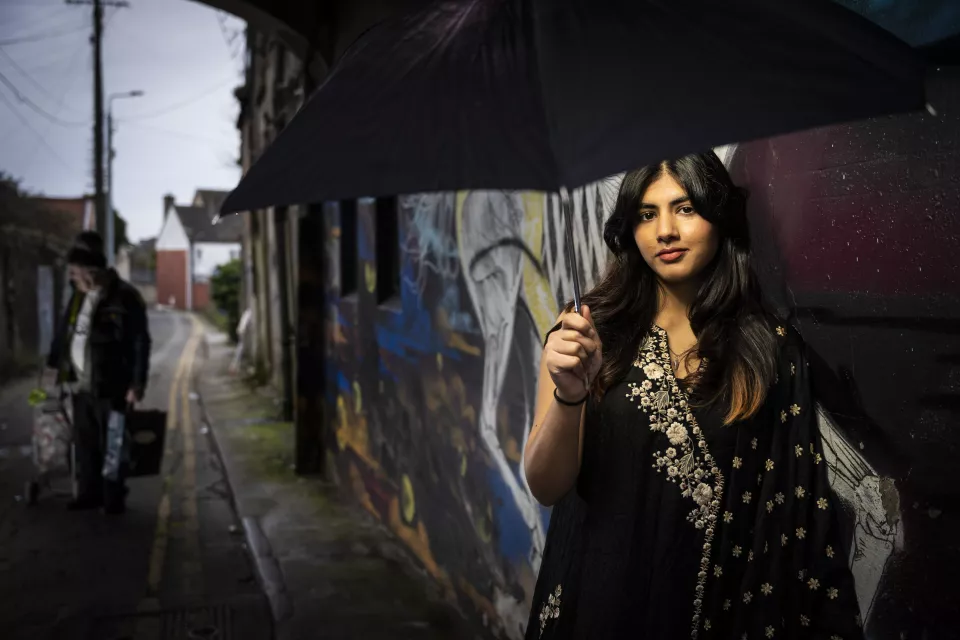
Arisha Atif, Pakistan
University of Limerick
Arisha Atif, studying Social Science, is wearing a traditional Pakistani dress, with her favourite piece being her "dupatta", which translates into shawl.
In Pakistan, dresses are worn daily, although they are not as brightly embroidered as this one. Rather, colourfully designed and shinier dresses are worn on special occasions, such as Eid or weddings. Because of the hot weather in Pakistan, these dresses are often made of light material, such as silk.
Arisha is pictured in Upper William Street in front of one of Limericks many street art installations. Renowned street artists from all over the world come to Limerick to make their mark, and what they leave behind are vibrant, evocative, uniting murals and messages.
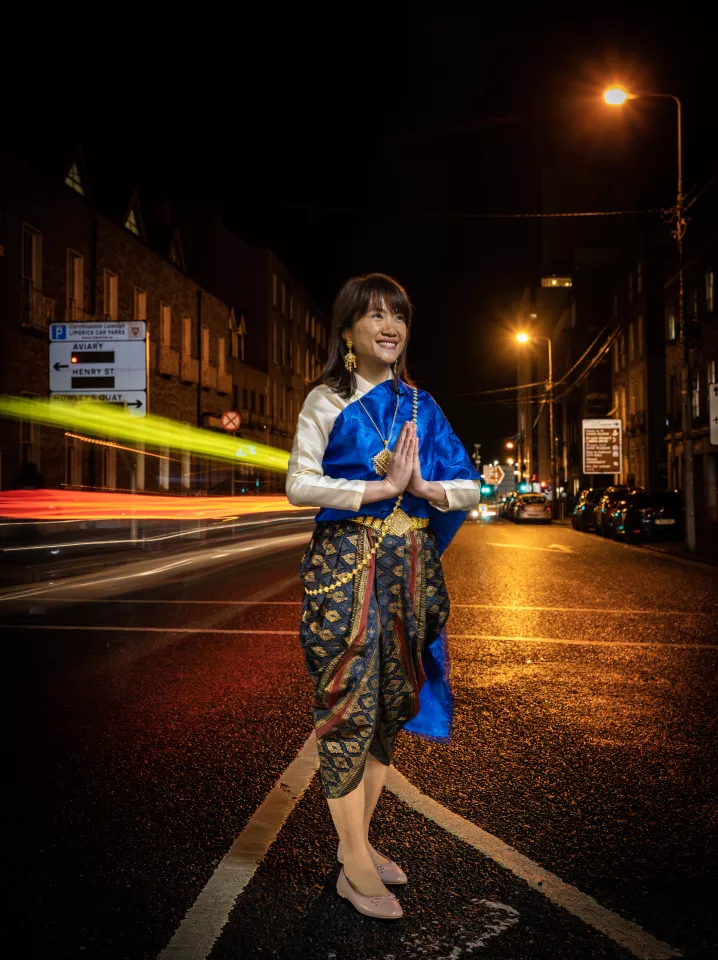
Rattapat Arayasompho, Thailand
Mary Immaculate College
Rattapat Arayasompho, is a PhD student in Mary Immaculate College. Rattapat is wearing a traditional Thai costume or "Chut Thai". It is an outfit worn for special occasions such as ceremonies, cultural events, weddings, and festivals. The costume varies depending on the reign, region and the occasion. This one is from the reign of King Rama IV (1851-1868), the period which clothing style was influenced by Western culture in an attempt to modernise the country. Women typically wear a long sleeve blouse and a wraparound cloth known as "Chong Kraben" on a lower part of the body. The outfit is usually worn along with accessories such as a sash or so called "sa-bai", a belt, and jewellery.
Rattapat is pictured at the junction of O’Connell Street and Mallow Street in the heart of Georgian Limerick, giving a unique view of the city centre at night.
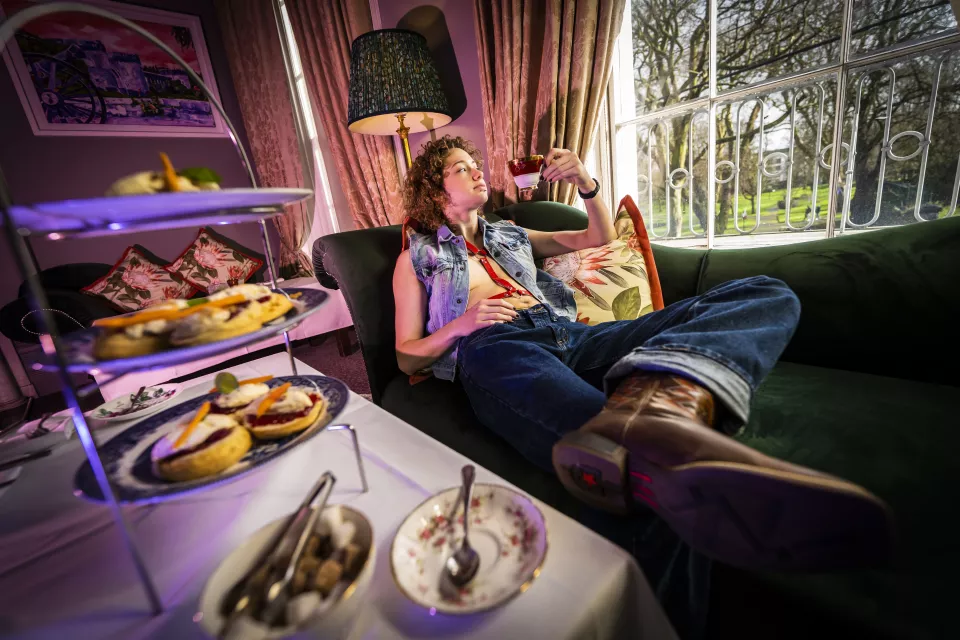
Hunter Sandy, USA
University of Limerick
Hunter is a biology student from Virginia, USA. He has come out as a male for over a year now and is wearing kinesthesiolopgy tape also known as trans tape under his harness.
Binding is a big part of transmasc dress for those fortunate enough to be able to. The leather harness alludes to queer leather culture that partly originated in San Francisco and the denim jacket is credited to being created by American, Levi Strauss, and while American Cowboys were a majority Black, Latin, or Native, Southern and Western Americans like to sport the style.
Hunter is pictured enjoying afternoon tea in the drawing room at No. 1 Perry Square while taking in the views of the magnificent People’s Park.
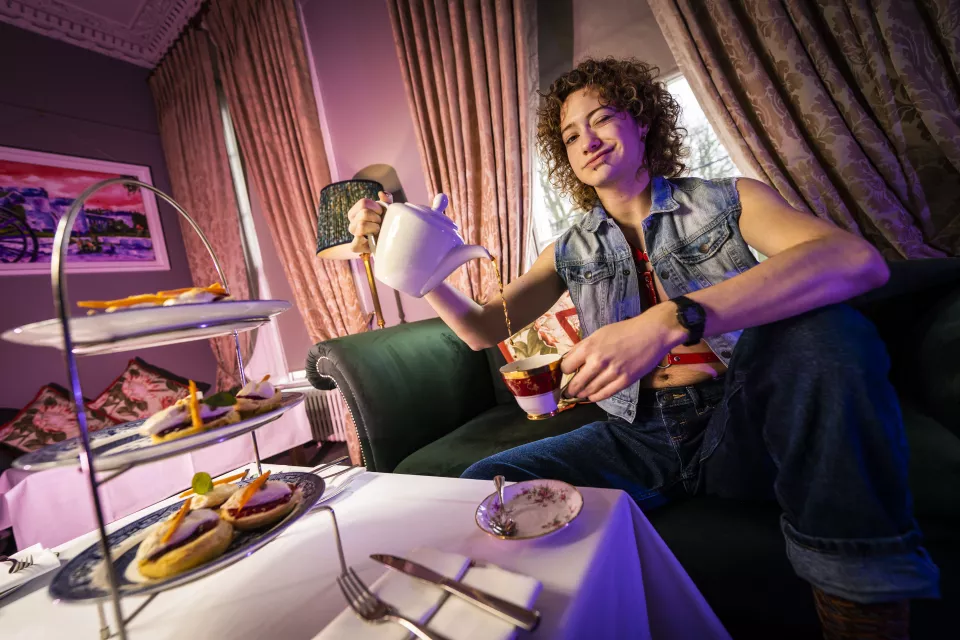
Hunter Sandy, USA
University of Limerick
Hunter is a biology student from Virginia, USA. He has come out as a male for over a year now and is wearing kinesthesiolopgy tape also known as trans tape under his harness.
Binding is a big part of transmasc dress for those fortunate enough to be able to. The leather harness alludes to queer leather culture that partly originated in San Francisco and the denim jacket is credited to being created by American, Levi Strauss, and while American Cowboys were a majority Black, Latin, or Native, Southern and Western Americans like to sport the style.
Hunter is pictured enjoying afternoon tea in the drawing room at No. 1 Perry Square while taking in the views of the magnificent People’s Park.
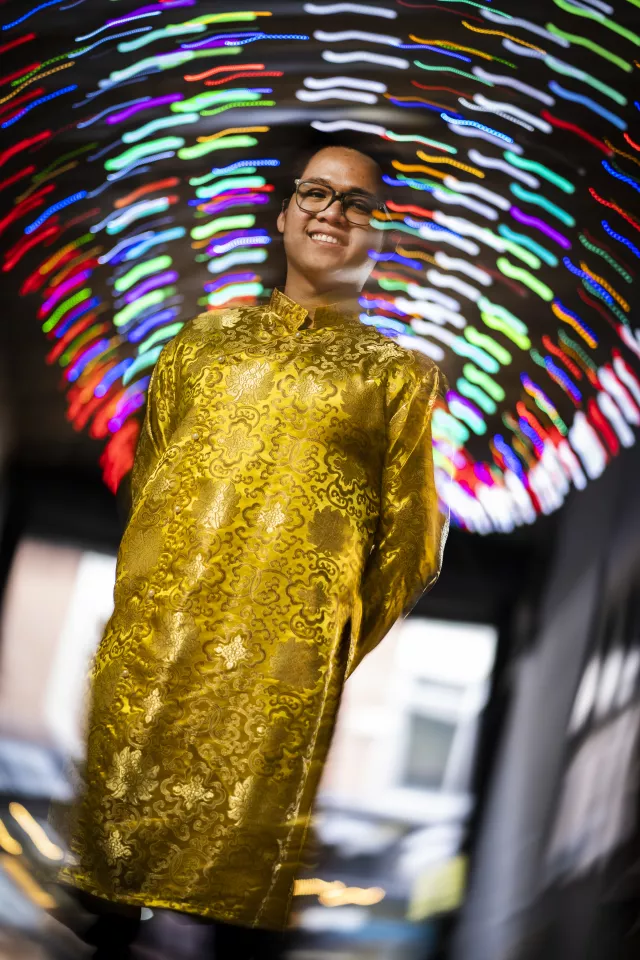
Nguyen Dinh Phan, Vietnam
University of Limerick
Nguyen, is from Hue, the citadel of Vietnam. He is doing the Master of International Commercial Law. He is wearing a traditional Vietnamese costume called 'Ao Dai'. 'Ao dai' in Vietnamese means long dresses. The "Ao dai' has two main parts: the pants and the tunic. In Vietnam, the 'Ao dai' is the traditional dress for women. Whereas Vietnamese men are dressed in 'Ao dai' in mandarin-style. With a tunic shorter and fuller than the ao dai, and the colour was traditionally determined by the man’s class and social rank. Nowadays, Vietnamese only wear 'Ao dai' on special occasions such as the Lunar new year. In my province, people believe that yellow is the colour of luck, therefore I always wear yellow 'Ao dai' every year during the Lunar new year. This year while all Asian countries such as China, Singapore, Japan, etc. consider 2023 to be the year of the Rabbit, it is actually the year of the cat in Vietnam.
Nguyen is pictured in the Lucky Lane, Catherine Street, semi-outdoor space with a roof over it, Works by local artists and painters adorn the walls and appear in various locations inside. The store sells an eclectic mix of clothes, accessories, furniture, and books.
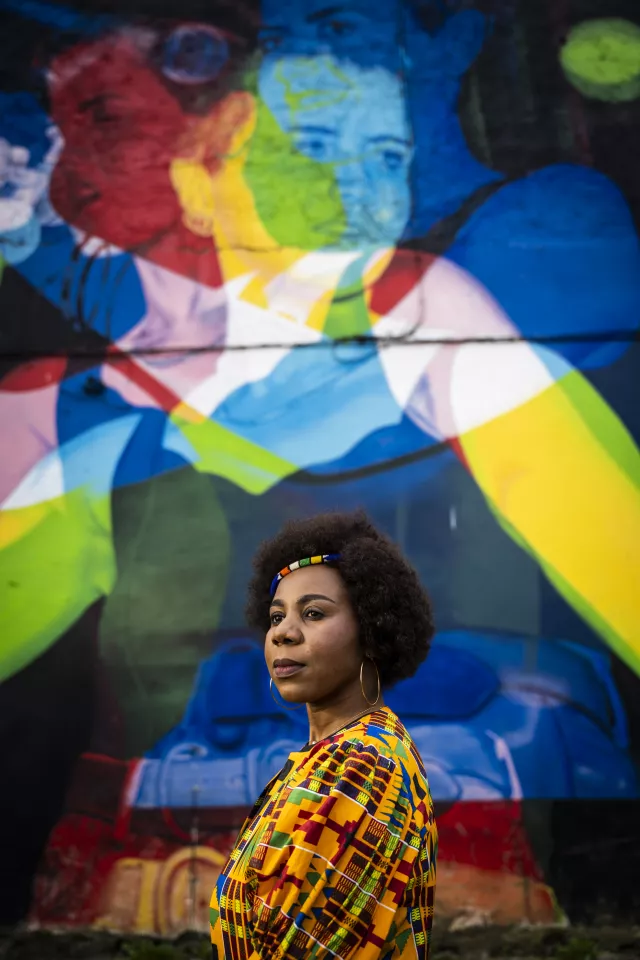
Merencia Nduru, Zimbabwe
Technological University of The Shannon
Originally from Zimbabwe, Merencia is studying Social Care and has been integrating into Irish culture, having originally come to Ireland as an asylum seeker.
As seen in the images, a great array of colours are present which all have different meanings. Green represents vegetation and agriculture. Yellow/Gold represents the country's mineral wealth. Red represents the blood shed during the war of the liberation. Black represents the black majority. White triangle represents peace. It comes together to directly reflect the Zimbabwean flag.
Merencia stands in front of the icon Dolores O’Riordan mural on Castle Street, This RGB-style mural immortalises The Cranberries lead singer at the peak of her career, honours her contribution to music and celebrates her proud connection to Limerick. The work of artist Aches, it was commissioned by Draw Out and funded by Limerick City and County Council as part of Celebrating Women in Limerick’s History series to recognise and honour influential and powerful women in Limerick.
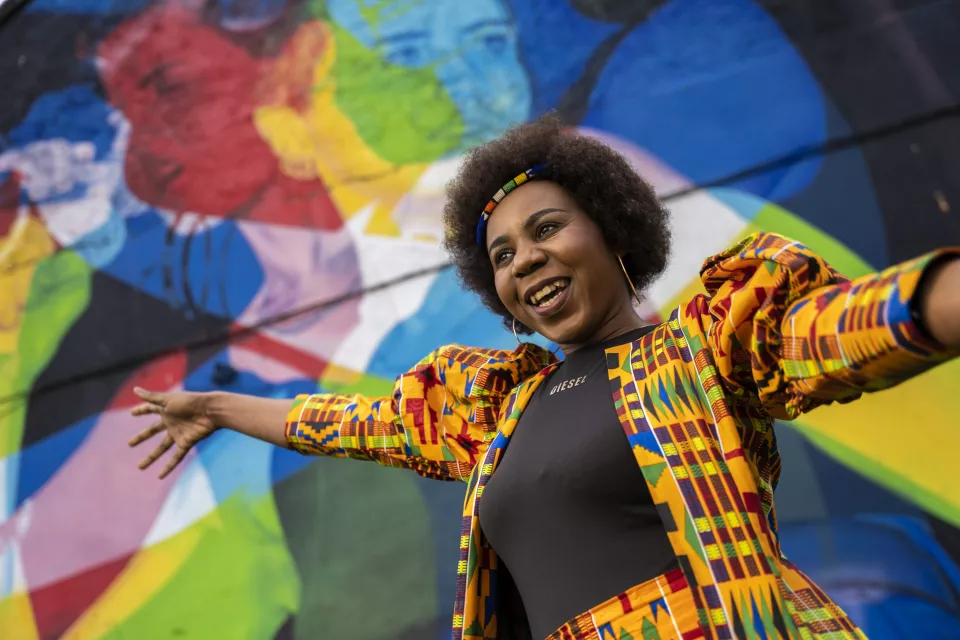
Merencia Nduru, Zimbabwe
Technological University of The Shannon
Originally from Zimbabwe, Merencia is studying Social Care and has been integrating into Irish culture, having originally come to Ireland as an asylum seeker.
As seen in the images, a great array of colours are present which all have different meanings. Green represents vegetation and agriculture. Yellow/Gold represents the country's mineral wealth. Red represents the blood shed during the war of the liberation. Black represents the black majority. White triangle represents peace. It comes together to directly reflect the Zimbabwean flag.
Merencia stands in front of the icon Dolores O’Riordan mural on Castle Street, This RGB-style mural immortalises The Cranberries lead singer at the peak of her career, honours her contribution to music and celebrates her proud connection to Limerick. The work of artist Aches, it was commissioned by Draw Out and funded by Limerick City and County Council as part of Celebrating Women in Limerick’s History series to recognise and honour influential and powerful women in Limerick.